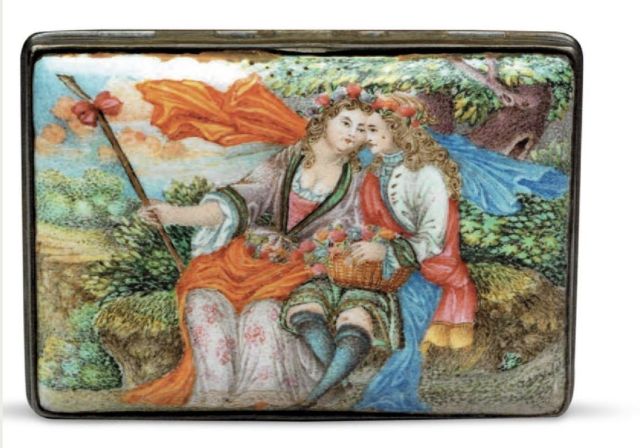Snuffboxes in China
- French Snuffbox
The earliest snuffboxes in China were brought by Christian missionaries from Europe. Missionaries gifted fanciful snuffboxes to the Qing emperors, who were particularly fond of special objects that showcased other peoples’ technology, paintings, music and architecture. Emperors called those objects ‘western curiosities,’ and often gave them to their officers as tokens of gratitude and special favor. Eventually, a snuffbox workshop was established inside the Qing palace, where new interpretations more catered to Qing elite culture were manufactured.
Yet, eighteenth-century Chinese snuffboxes emulated European ones in many aspects. Firstly, Chinese snuffbox makers applied the enamel technique which they had learned from Europeans in China. Decorations in enamel were made by applying enamel materials in copper products and firing them. Enamel decorations caught the imperial eye as soon as enamel articles arrived in China. Because the surface of the enamel after firing is generally blue, it is also called Jingtailan. Just like in Europe, Qing snuffbox makers often used enamel for decorating boxes. For example, in the first picture (snuffbox with Western figure painted in enamel made by Qing craftsman Hu Siming), this Qing snuffbox has the same enamel miniature decoration as our snuffbox, with the scene of Venus and Cupid. Moreover, through this example, we can find that Chinese snuffbox makers also used Western mythology for the content of the miniature paintings.
As the first picture illustrates, craftsmen in Qing palaces emulated European print paintings just as other manufacturers in China applied the patterns on the export porcelains of the time. The snuffbox in this picture depicts a scene from Roman mythology. The wooden stick held by the woman in the miniature is an important symbol of the Roman goddess of agriculture, Chrys. The flower basket on the man's lap is derived from Bacchus, the god of wine, who often held a basket of grapes. This Roman mythology expresses a beautiful idyllic spring scene. Just like the European snuffbox, the miniature of Venus and Cupid expresses the striking symbolism of love and beauty. Besides the enamel technique and the miniature pattern, the tobacco in Chinese snuffboxes also came from Europe, according to Chinese records. Zhao Zhiqian wrote that "Snuff came from Italy, a country beside the Atlantic Ocean. It was brought to China by Matteo Ricci during the period of the Wanli emperor during the Ming Dynasty (1571-1620)." It may be that missionaries or foreign ambassadors paid tribute to China, or merchants brought it to China for trade.
Qing manufacturers later changed snuff boxes to cater to Qing tastes. The shape and material of snuffboxes were made more in line with Chinese aesthetics. The oval-shaped gilded snuff box evolved into a small porcelain medicine bottle-shaped snuff bottle (fig. 2). It is possible that when snuff was first introduced to China, people used medicine bottles to store it. On the one hand, China's porcelain firing technique was more advanced than the technique for making gold ware. On the other hand, the Ming and Qing royal families were more interested and familiar with porcelain. During the Qianlong period, a new technique called “inner painting” was developed (fig. 3). The inner paintings in the snuff bottles were produced by manipulating a specialized paint brush through the neck of the glass bottle. This technique grew to maturity during the 19th century. Snuffboxes thus also reflect the cultural exchange between East Asia and Western Europe in the 18th century.

](https://micrio.thingsthattalk.net/ciTTc/views/max/640x640.jpg)
](https://micrio.thingsthattalk.net/KOTPJ/views/max/640x640.jpg)